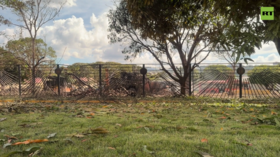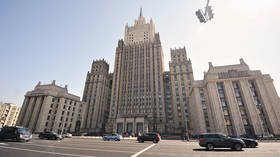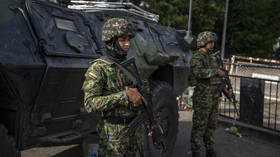Poland, Lithuania discussing plans with Washington to harbor US army equipment
Warsaw and Vilnius are in talks with Washington about the permanent stationing of US army equipment warehouses, officials from the two countries said. Heavy weapons may be stored in the Baltic States, Romania, Bulgaria and possibly Hungary.
The Polish Defense Ministry tweeted that during his recent visit to Washington Defense Minister Tomasz Siemoniak was given assurances that a final decision on stationing the warehouses would be taken shortly.
Citing US and allied officials, the New York Times reported on Saturday that heavy equipment would be stored in each of the three Baltic nations: Lithuania, Latvia and Estonia, plus some Eastern European countries - Poland, Romania, Bulgaria and possibly Hungary.
The Pentagon's far-reaching proposal requires approval from Defense Secretary Ashton B. Carter and the White House. Should the move be given the go-ahead, it would be the first deployment of military hardware in Europe since the end of the Cold War 25 years ago. The plan falls short of a permanent boots-on-the-ground presence.
READ MORE: US considers storing heavy weapons in Baltic and Eastern Europe – report
When NATO initially expanded into the Baltic States in 2004, permanent stationing of equipment and troops in these countries wasn’t undertaken - a mark of respect to Russia’s interests. But with the unfolding Ukraine crisis, NATO and Washington began to bolster forces in the region, openly sending a message to Moscow that NATO will defend its alliance members.
“This is a very meaningful shift in policy. It provides a reasonable level of reassurance to jittery allies, although nothing is as good as troops stationed full-time on the ground, of course,” James G. Stavridis, a retired admiral and the former supreme allied commander of NATO, now dean of the Fletcher School of Law and Diplomacy at Tufts University, told the New York Times.
According to the newspaper, the Pentagon is "poised to store" battle tanks, infantry vehicles and other heavy weapons for 5,000 American troops in the Baltic and Eastern European states. The stocks, planned to be stored on allied bases, would be reportedly the same as the Pentagon kept in Kuwait for over a decade after the 1990 US invasion of Iraq.
Lithuanian Defense Minister Juozas Olekas also told Reuters on Sunday that Vilnius is getting ready to host heavy US military equipment. Talks are underway with Washington on a permanent location for the arms.
"We think that at least part of it [Abrams and Bradleys] will be in Lithuania and we are in the process of preparing our military infrastructure, so it can be used for such pre-positioning. It is almost ready," Olekas said.
READ MORE: NATO starts ‘very high readiness’ force drills in Poland
"We have been in talks with our American allies about locating equipment here on a permanent basis, in order to increase our security and support the soldiers stationed here," he added.
"If the decision is taken, it will be very positive for our security," Olekas concluded.
Estonia’s Defense Minister Sven Mikser has said the US proposal will be discussed with NATO countries on June 24-25, the Delfi news portal reports.
READ MORE: 49 NATO vessels, 5,600 troops gear up for major US-led drills in Baltics
Since Crimea’s reunion with Russia, concerns have been growing in Moscow over a sharp increase in the intensity of the training of NATO troops along Russia’s border. Since the outbreak of the military conflict in eastern Ukraine, NATO forces have stepped up military drills in the Baltic States and Eastern Europe.
Around 50 vessels from 17 countries, involving some 5,600 troops, are currently taking part in the US-led BALTOPS exercise in the Baltic Sea. NATO member states, such as Belgium, Canada, Denmark, Estonia, France, Germany, Latvia, Lithuania, the Netherlands, Norway, Poland, Turkey, the UK and the US have sent naval forces to take part in the drill. They were also joined by three NATO partners – Finland and Sweden, which both have access to the Baltic Sea, and also Georgia. The show-off of anti-submarine warfare, air defense, interception of suspect vessels and amphibious landings runs through June 20.
The head of the Main Operation Directorate of General Staff, Lieutenant General Andrey Kartapolov, said in April that the intensity of NATO’s operational and combat training activities grew by as much as 80 percent in 2014, with bombers from the US Air Force performing strategic tasks during their military exercises. Russia has also increased the number of flights of its long-range ‘Bear’ Tupolev-95 bombers near NATO members’ air space, as well as carrying out large-scale drills on its own territory.











